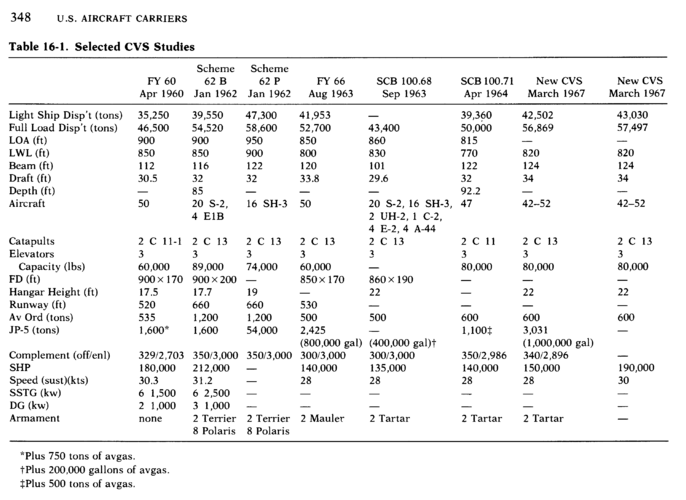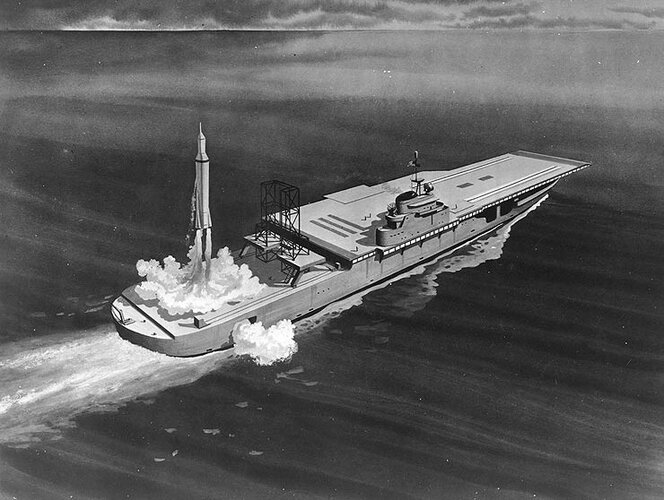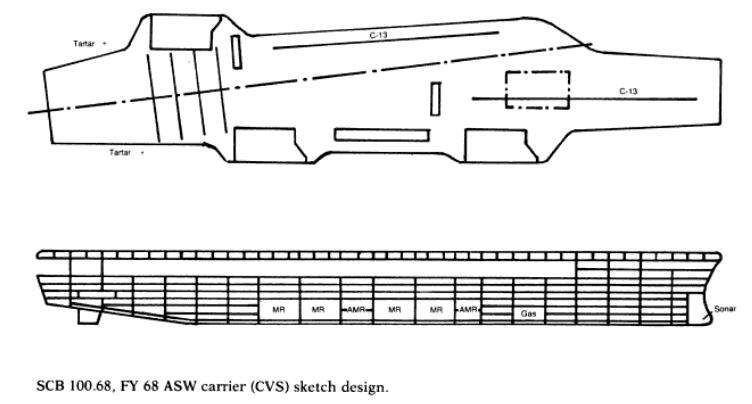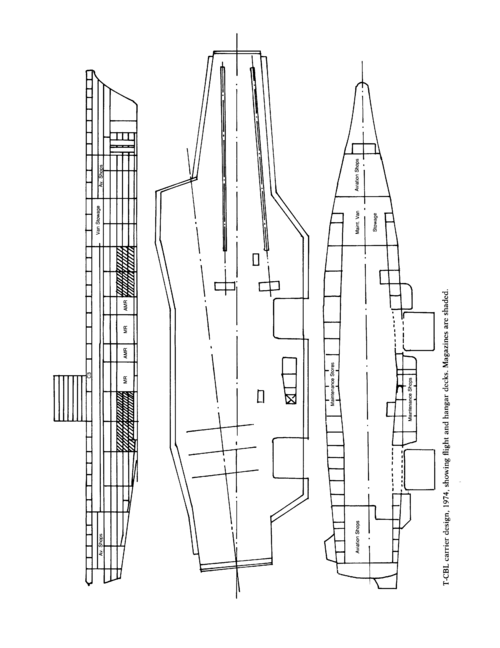Indeed there were a number of ASW carrier designs from the 1960's
I have data for these:
CVS Scheme 60 - 1960
Dimensions: 259,08(wl) x 274,32(oa) x 51,81 x 9,29m
Displacement: 35.250tons (standard) 46.500tons (Full Load)
Engines: 180.000shp Steam Turbines, 4 shafts
Speed: 56km/h (30knots)
Armaments:
Unknown,
50x aircrafts
CVS Scheme 62A - 1962
Dimensions: 259,1(wl) x 274,32(oa) x 60,96m
Displacement: 38.500tons (standard) 53.170tons (Full Load)
Engines: 150.000shp Steam Turbines, 4 shafts
Range: 14.800km (8.000nm)
Speed: 56km/h (30knots)
Armaments:
2x4 RGM-27 Polaris
2x2 RIM-2 Terrier
60x aircrafts (Likely 20x F-4 Phantom II, 20x S-2 Tracker 4x E-1 Tracer 16x SH-34)
CVS Scheme 62B - 1962
Dimensions: 259,1(wl) x 274,32(oa) x 60,96m
Displacement: 39.550tons (standard) 54.250tons (Full Load)
Engines: 212.000shp Steam Turbines, 4 shafts
Range: 14.800km (8.000nm)
Speed: 58km/h (31,5knots)
Armaments:
2x4 RGM-27 Polaris
2x2 RIM-2 Terrier
60x aircrafts (Likely 20x F-4 Phantom II, 20x S-2 Tracker 4x E-1 Tracer 16x SH-34)
CVS Scheme 62N - 1962
Dimensions: 274,32(wl) x 289,56(oa) x 60,96 x 9,75m
Displacement: 42.600tons (standard) 54.000tons (Full Load)
Engines: 135.000shp Nuclear Reactors, I think A3W and 3 shafts
Speed: 55km/h (29,5knots)
Armaments:
2x4 RGM-27 Polaris
2x2 RIM-2 Terrier
60x aircrafts (Likely 20x F-4 Phantom II, 20x S-2 Tracker 4x E-1 Tracer 16x SH-34)
CVS Scheme 62P - 1962
Dimensions: 274,32(wl) x 289,56(oa) x 60,96 x 9,75m
Displacement: 47.300tons (standard) 58.600tons (Full Load)
Engines: 180.000shp Nuclear Reactors, I think A3W and 4 shafts
Speed: 58km/h (31,5knots)
Armaments:
2x4 RGM-27 Polaris
2x2 RIM-2 Terrier
60x aircrafts (Likely 20x F-4 Phantom II, 20x S-2 Tracker 4x E-1 Tracer 16x SH-34)
CVS Design 1963
Dimensions: 243,84(wl) x 259,08(oa) x 51,81 x 10,3m
Displacement: 41.953tons (standard) 52.700tons (Full Load)
Engines: 140.000shp Steam Turbines, 4 shafts
Range: 14.800km (8.000nm)
Speed: 52km/h (28knots)
Armaments:
2x9 RIM-46 Sea Mauler
50x aircrafts
CVS Design 1964 Scheme K - SCB-100.71
Dimensions: 234,69(wl) x 248,12(oa) x width unknown x 9,75m
Displacement: 39.360tons (standard) 50.000tons (Full Load)
Engines: 140.000shp Steam Turbines, 4 shafts
Range: 14.800km (8.000nm)
Speed: 52km/h (28knots)
Armaments:
2x2 RIM-24 Tartar
47x aircrafts
CVS Design 1966
Dimensions: 250(wl) x width unknown x 10,36m
Displacement: 43.030tons (standard) 57.497tons (Full Load)
Engines: 190.000shp Steam Turbines, 4 shafts
Range: 22.200km (12.000nm)
Speed: 56km/h (30knots)
Armaments:
Unknown,
52x aircrafts
CVS Design 1968 - SCB-100.68
Dimensions: 252,98(wl) x 262,13(oa) x 57,91 x 9,02m
Displacement: 43.400tons (standard) 53.622tons (Full Load)
Engines: 135.000shp Steam Turbines, Likely 3 shafts
Range: 14.800km (8.000nm)
Speed: 52km/h (28knots)
Armaments:
2x2 RIM-24 Tartar
63x aircrafts (Likely 20x F-4 Phantom II, 20x S-2 Tracker 4x E-2 Hawkeye, 1x C-2 Greyhound, 16x SH-34, 2x UH-2)







